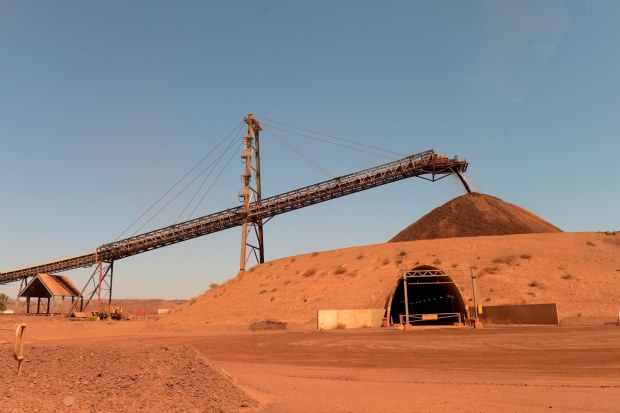Rio Tinto cuts dividends and jobs as Pilbara costs surge
Peter KerResources reporterUpdated Feb 20, 2025 – 8.38am,first published at 6.01amListen to this article6 minRio Tinto will pay its lowest dividend in seven years and cut costs at its Australian iron ore division after full-year profits fell by 8 per cent on the back of higher production costs and lower prices for the commodity.
Rio shareholders will receive a $US2.25 ($3.55) per share final dividend on April 17, after the miner posted a weaker-than-expected $US10.86 billion underlying profit for 2024.
Rio Tinto Group’s Gudai-Darri iron ore mine in the Pilbara, the unit cost of production in the region rose by 7 per cent to $US23 a tonne. Carla Gottgens
Analyst consensus had pointed to a $US10.98 billion underlying profit.
Weaker demand for property development in China was the major factor in the slide, driving an 11 per cent fall in prices for Rio’s iron ore during 2024. That downturn could not be offset by an 8 per cent rise in prices for Rio’s copper and aluminium.
While prices for Rio’s iron ore declined over the past year, the unit cost of production in Australia’s Pilbara region rose by 7 per cent to $US23 a tonne.
Related Quotes
RIORio Tinto
$123.460 2.81%View RIO related articlesFeb 24May 24Aug 24Feb 25104.50114.00123.50133.00142.50Updated: Feb 21, 2025 – 1.25pm. Data is 20 mins delayed.Rio said on Thursday that unit costs would rise again this year by up to 6 per cent to between $US23 and $US24.50 a tonne.
The Pilbara iron ore division has suffered severe inflationary pressures over the past decade; unit costs were $US13.30 per tonne in 2018.
While some inflationary factors in the Pilbara have eased – such as diesel prices – other cost factors will continue to rise, such as the distance covered by Rio’s mining trucks as they carry ore from increasingly remote mines to fixed infrastructure like railways.
Rio chief financial officer Peter Cunningham said that “strict cost management” was now being enforced upon the iron ore division, and the number of “full-time equivalent” workers in the West Australian division was 3 per cent lower in December than at the same time in December 2023.
Rio put its Australian staff numbers at 25,724 on Thursday; up from 24,535 at the same time last year, with close to 16,000 of them in iron ore. Based on those numbers, close to 480 roles have been cut.
Efforts to rein in costs in the Pilbara have been hampered by cyclones over the past seven weeks, which have meant about 13 million tonnes in lost production.
Despite the weaker result, Japanese giant Mitsui delivered a major vote of confidence in Rio’s Australian iron ore division on Wednesday by paying $US5.34 billion ($8.4 billion) for a 40 per cent stake in the Rhodes Ridge mine that Rio plans to build over the next five years.
Rio chief executive Jakob Stausholm told investors on Thursday morning that Mitsui’s huge spend on the project, which will run between 2030 and 2055, should prompt the investment community to upgrade their valuations on the Australian iron ore division.
Weak return for shareholders
The $US2.25 per share final dividend announced on Thursday brought the total dividends for the year to $US4.02, the weakest return for Rio shareholders since 2017.
It marks a return to Earth for Rio investors after a golden era of shareholder returns, and comes after BHP paid its lowest half-year dividend in eight years on Tuesday.
Rio’s policy is for dividends to be between 40 per cent and 60 per cent of underlying earnings, and Thursday’s pay-out was at the top of that range.
Stausholm said he was increasing investments in new projects such as Guinea’s Simandou to deliver “a decade of profitable growth”.
Rio has also vowed to rapidly increase copper production at Mongolia’s Oyu Tolgoi mine in coming years but could be hampered on that mission if it cannot swiftly strike a deal with Canadian explorer Entree Resources to incorporate nearby tenements into the mine plan.
The Australian Financial Review revealed in November that Rio was racing to strike a deal with Entree to ensure production was not affected, and on Thursday Stausholm said he was “getting closer” to fixing the issue, adding that it would be “nice to get that solved in the not too distant future”.
Rio took a $US503 million impairment on its Queensland alumina refineries after discovering that a “double digestion” project to curb carbon emissions would cost more to build than previously expected.
Reports in January suggested Rio and Glencore briefly held talks over a possible merger.
Glencore chief executive Gary Nagle declined to confirm the talks when asked on Wednesday evening. Glencore posted a $US1.63 billion loss for the year, with underlying earnings before interest and tax of $US6.93 billion.
The underlying profit was 33 per cent lower than last year, with the slump driven by weaker prices for coal.
Despite the weaker prices, Australian thermal coal was Glencore’s biggest earner, delivering the group $US1.57 billion of adjusted EBIT. This was more than Glencore’s entire copper division, which delivered just over $US1.2 billion of EBIT.
Australian coking coal delivered a further $US438 million of earnings, the Australian nickel division delivered $US24 million while the Australian zinc mines lost $US74 million.
Nagle said high electricity prices in Australia were making life hard for its Queensland copper smelter, but he was encouraged by the attitude of the state’s new premier, David Crisafulli.
Nagle rejected the notion that Glencore’s large coal business was an impediment to striking a merger with a big peer, given that those peers tended to be owned by many of the same investors who owned Glencore.
Rio divested the last of its coal mines in 2018 and Stausholm said on Thursday morning that he had no intention to take Rio back into coal.
Nagle said he was actively considering leaving the London Stock Exchange and was studying alternative options.
A listing in New York seems the most probable destination for Glencore, however, some investors have tried to convince Nagle to list on the ASX.
- Forums
- ASX - By Stock
- Ann: Dividend/Distribution - RIO
RIO
rio tinto limited
Add to My Watchlist
0.96%
 !
$115.81
!
$115.81
Rio Tinto cuts dividends and jobs as Pilbara costs surgePeter...
Featured News
Add to My Watchlist
What is My Watchlist?
A personalised tool to help users track selected stocks. Delivering real-time notifications on price updates, announcements, and performance stats on each to help make informed investment decisions.
 (20min delay) (20min delay)
|
|||||
|
Last
$115.81 |
Change
-1.120(0.96%) |
Mkt cap ! $42.99B | |||
| Open | High | Low | Value | Volume |
| $116.50 | $117.43 | $115.81 | $112.8M | 971.2K |
Buyers (Bids)
| No. | Vol. | Price($) |
|---|---|---|
| 8 | 1571 | $115.80 |
Sellers (Offers)
| Price($) | Vol. | No. |
|---|---|---|
| $116.30 | 500 | 1 |
View Market Depth
| No. | Vol. | Price($) |
|---|---|---|
| 8 | 1571 | 115.800 |
| 1 | 1000 | 115.750 |
| 1 | 700 | 115.720 |
| 1 | 1000 | 115.700 |
| 1 | 1000 | 115.690 |
| Price($) | Vol. | No. |
|---|---|---|
| 116.300 | 500 | 1 |
| 116.500 | 50 | 1 |
| 116.700 | 156 | 2 |
| 116.750 | 621 | 2 |
| 116.780 | 958 | 1 |
| Last trade - 16.14pm 30/07/2025 (20 minute delay) ? |
Featured News
| RIO (ASX) Chart |






